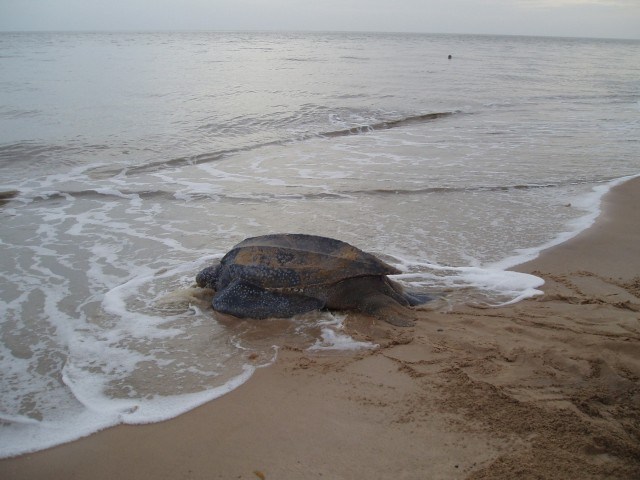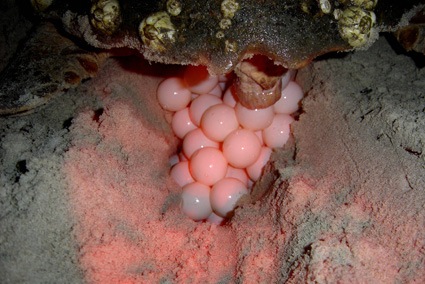A few days ago, we rented a 4×4 for the week and put it to good use checking out a local leatherback sea turtle nesting site on Playa Grande, here in Costa Rica. After calling around for 3 days we finally snagged the elusive Tamarindo car rental. Every place we checked out the previous week suddenly had none in stock when we went to pick one up. It seems the busy season has hit this area in Costa Rica in full force.
We were originally going to get a car but due to the insanely bad roads in Costa Rica we decided to spend a few more dollars and get something with better shocks and higher ground clearance. We went on a major excursion the other day and I have to say we’re glad we didn’t go with a car. I’ll be posting that whole story in another post but suffice it to say, we’re enjoying being mobile these days.
One of the first places we happened to check out with the new wheels was Playa Grande to check out the endangered leatherback sea turtle nesting site.
Playa Grande is the next beach north of Tamarindo. It’s basically separated from Tamarindo by a small estuary and you can get across it by paying a boat driver a few dollars to take you. It’s a very long beach, however, and quite the walk to get to any place of note. I will admit that it has decent sand and not only is it one of the best beaches to surf on in the country, but it’s also the site of a world famous nature reserve.
The Las Baulos National Park
The Las Baulos National Park was created solely to protect the endangered Pacific leatherback sea turtle nesting sites that line the area. In case you don’t know much about leatherback turtles, they’re easily the biggest turtle in the world (on land or in the water), they have a soft shell and, due to a lot of reasons, their numbers have dwindled considerably over the past twenty years.
Luckily for us, the Pacific leatherback sea turtle also happens to lay it’s eggs on Playa Grande every December until February. We had been thinking of taking a tour out of Tamarindo since we got here but because of timing issues we hadn’t gotten around to it. With our own vehicle we managed to save ourselves about $75 so we were glad we waited.
As I was previously saying, we had decided to check out the beach over at Playa Grande. As we got closer to the beach we saw the signs pointing to the rangers station at Las Baulos National Park and decided to check out their leatherback sea turtle nesting information. As we walked in one of the rangers asked if we wanted to put our names down on the tour list for that night. We hadn’t really decided but when asked so directly we knew it was now or never.
At Las Baulas National Park (Parque Marino las Baulas), they have a policy that they only charge if there’s a sighting ($25 an adult and kids are free) and we heard that you have to show up early if you want to get a place on the list. Because they only allow a certain amount of people on the beach every night, the spots tend to fill up fast. Usually the rangers are out and about most days so the fact that one was in and willing to put our names down to see the leatherback sea turtle nesting we took it as a good sign.

Almost didn’t make it
With the knowledge that we were going to have to come back in a few hours we decided to end our beach tour early and went back to the condo for a short nap and a quick bite to eat. The tour started at 6 but often depends on high tide so some nights it can occur much later in the evening. It took us nearly 30 minutes to drive back to our condo so supper turned out to be a bag full of sandwiches, some fresh cut up fruit and drinking boxes. Needless to say the kids enjoyed it tremendously.
One of the quirky things about this area (and Costa Rica in general) is that most beaches are nearly impossible to get to directly. You almost always need to drive inland then back to the coast to get to the next beach. Waterways, mountains and inhospitable grounds seem to separate all the beach towns. Some places can take 10 times longer to get to then a kayak or even walking down the beach would take. It’s a little frustrating especially when the roads running inland are so bad to begin with.
We arrived back at Playa Grande a little after 6. It was still light out and we had already gotten our names down so we weren’t in a rush to be there any earlier. As we walked in we gave the ranger our names (they had used a photocopy of our passports earlier to get our information). In response they gave us back two numbered tags. The tags read 31 and 32. It didn’t seem that there were that many people ahead of us on the list but we never thought twice about it. It turns out that those numbers meant quite a bit…
The Leatherback turtle presentation
After finishing our bagged supper on the veranda along with a bunch of other people, the kids decided they needed a little exercise. Usually our kids are fairly quiet and well behaved but they were a little over active that night. The people around us didn’t seem to mind their excitement until we were all ushered into the presentation room.
Micki and I had to pull out all the tricks to keep them quiet while one of the rangers showed us a presentation on the plight of the leatherback sea turtle nesting sites and their diminishing existence. Of course humans with our over zealous fishing practices, our desire for beachfront property and our ability to pollute everything we touch are to blame however I’m not pointing fingers, except at you Bob, yeah, you know what I’m talking about. 😉
It was toward the end of the presentation that Micki’s and my dreams of seeing one of these gargantuan ancient beings was nearly denied. Our chance to get up close and personal with something that has outlived the dinosaurs was rapidly diminishing.
In the late 80’s and early 90’s there were almost 1600 leatherback turtles that had laid eggs on Playa Grande. The previous year saw only 32!
There’s been a very steady decline of leatherback sea turtles nesting there for the past 20 years. This year they had seen 34 so far (they have spotters out all night recording any sightings) and had a double nesting the night before. The two nights prior to that they had spotted nothing. On top of those dismal odds, we found out that they can only take 30 people per sighting. Seeing that we had tickets 31 and 32 we weren’t eligible to go see the first leatherback sea turtle nesting and had to hope for a second to show up. The chances for that were even less than we hoped.
As we sat in the presentation room talking with another couple (they were holding tickets in the 30’s as well) Micki and I considered calling it quits. It was still early enough and we only had to pay if we saw a turtle so all in all it wouldn’t have been a big loss. We weren’t sure we could (or even wanted to) sit around waiting until midnight with the kids for the leatherback sea turtle nesting only to be sent home with nothing to show for it.
It was around this time that people started running around in a slight panic. A leatherback sea turtle nesting had just been spotted and was already digging it’s nest out. As we let out a collective sigh one of the rangers asked us what our number was. We sadly said 31 and 32 and they said to get our butt’s in gear. It seems some people hadn’t shown up and we now made the cut!

A mad dash
In a mad rush everyone quickly lined up outside the office and took turns paying the $25 per person fee. After that, everyone jumped into their respective cars (or tour bus if they came with a packaged tour) and we all lined up in a row on the street. After that came a mad race down rutted back roads and through a few gated areas.
It seems that Playa Grande is named after the length of the beach and Playa Grande basically means Large Beach. The rangers said you can walk it however by the time you managed to reach where the leatherback sea turtle nesting was it would have been long gone already. After 10 minutes of crazy gravel driving and dodging car sized potholes we arrived at the spot. Or so I thought…
Once all the vehicles were parked we all met up at the lead car. With two rangers (one in front, another in the back) we all slowly made our way through a small forest down to the beach. They only allow red lights on the beach since regular lights confuse the turtles and they’ll often not come up on the beach if there are too many distractions. As such, only the rangers had some. The rest of us blindly followed the person in front of us hoping that we did’t stumble on a root or lizard.
Looking back, it was quite insane but luckily the stars were shining in full force and with no competing lights (people aren’t allowed to let any lights show from the beach in Playa Grande) we all made it to the beach unharmed. Once we were on the beach we all got in single file (they don’t want anyone tramping over existing turtle nests) and made a dash for the nesting site.
I’m not sure dash is the correct term to be honest. It was more of a kilometer long sprint running in the sinking sand with only the crashing surf and the stars to guide us. A few times we thought we were there but it was only the lead ranger patiently waiting for us before he took off at a jog to another area further away. Every time people slowed down the back ranger would urge us onwards at a quicker pace. It seems that turtles don’t like waiting for a bunch of gawkers to lay their eggs.
I don’t know whether it was the excitement, the fact that the sun wasn’t roasting me alive or the fact that Jordan kept saying go go but I somehow found myself in the lead and was practically pulling the group along with me. It wasn’t until we finally reached the turtle that I realized how far and how quickly we had gone. I had done it all with Jordan in my arms and was literally soaking wet when we stopped.
We Get to Watch a Leatherback Sea Turtle Nesting
Somehow, another group of people were already there and the sea turtle was almost half finished laying her eggs. She was huge. She was almost 5 feet in length and 4 feet in width and that doesn’t include her head or her tail. She probably weighed over 1000 pounds and she was laying eggs like crazy. Jordan and I got to get right down practically in the hole and watch as she deposited them into the hole she had already dug out.
Sea turtles go into a zen like trance as they lay their eggs and it’s only at this point when they’re actually laying them that it’s relatively safe to approach without scaring them off.
One of the rangers was right there as well counting every good egg and Micki and Cole were on the other side. It was amazing to see. After a bit we gave other people a chance to get a close look and after a bit our whole group backed off to give the other group another chance. Once they had all seen we got to get up close and watch again.
When she was finished dropping off all the eggs (88 fertile eggs and almost as many non fertile) she started to cover the hole up. Her back legs seemed pretty strong at first but it wasn’t until she started using her front flippers that you realized how powerful those nesting leatherback sea turtles can be. She was easily throwing sand back 15 feet. Micki and Jordan got quite the mouthful and Jordan was laughing like a madman. She thought the turtle was playing with her.
Quiet contemplations and nature sanctuaries
Once the turtle was nearly finished covering up the mound, our group all lined up (2 abreast this time) and we slowly made the trek back to our vehicles. With the thundering surf crashing right next to us we couldn’t talk much but I know each of us was savoring the walk. It was a lot more leisurely than when we came and it gave us a great chance to check out the sky and the lights from Tamarindo in the distance.
Cole and Jordan both enjoyed seeing the leatherback sea turtle nesting and it saddens me that at the rate they seem to be going, the Pacific Leatherback could easily disappear within the next decade. They say that only 1 in a 1000 eggs survive to lay eggs themselves and though the leatherback turtle can live well over 30 years that they almost rarely make it back to lay a second clutch the typical 3 or 4 years after their first batch.
That all being said, it’s nice to see a group of people (rangers and tons of volunteers alike) committed to keeping the leatherback around for as long as possible. With parks and sanctuaries expanding right across the world it’s even possible that the leatherback turtle makes a comeback.
If not, I’m glad my children got a chance to see these giant, beautiful creatures while they’re still here. It also helps validate why we’re on this trip and proves to us that Costa Rica is more than just ziplines and miles of beaches.
Mile for mile, there’s more nature in this one country than almost any other place on earth. All you need to do to experience it is open up your balcony and look around. It floods in like a storm and makes you never want to close it up again. Now if only those howlers would let me sleep in once in a while…






